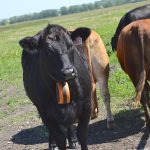In the U.S., data collected from farmers and surveys on field practices and products help determine impact on the bottom line
Visitors to university campuses may have seen the poster of Albert Einstein holding up a test tube beside the words, In God We Trust, All Others Must Show Data.
The slogan also applies to agriculture.
Producers and scientists always want to know if a certain agronomic practice, such as a fungicide application to a flax crop, pushes yields up or down.
More broadly, politicians need detailed agricultural data to make decisions about controversial policies such as insecticide regulations.
That’s why the U.S. Department of Agriculture’s Economic Re-search Service uses the Agricultural Resource Management Survey (ARMS) to interview thousands of American producers every fall.
Read Also

Why feds imposed EV tariffs
Moe and Kinew have a fight on their hands when it comes to eliminating the EV tariff. Canada has to worry about pissing off the U.S. and Mexico and hundreds of thousands of auto workers.
The department gathers information on farm finances and crop production practices and publishes the data at http://1.usa.gov/1W5KvCD. Topics include fertilizer and pesticide use, labour and tillage.
Visitors to the website can select a crop and find a large amount of data, including the number of herbicide treatments, classifications of insecticides used and the percentage of acres treated with phosphate.
Canada’s federal government doesn’t have a comparable website because Agriculture Canada doesn’t conduct such a survey.
Since 2006, Health Canada has required farm chemical companies to report annual pesticide sales data. An annual 50-word summary of the data, up to 2012, is available on the Health Canada website at http://bit.ly/1QJKEss.
However, the website doesn’t include a convenient table where users can look up information about specific crops or certain practices or application rates.
Canadians who want a copy of the latest report must contact Health Canada and then wait for a “subject matter expert” to review the request.
Jeanette Gaultier, a Manitoba Agriculture pesticide specialist, said the federal government is planning to publish pesticide sales data for specific provinces, but she’s not sure if that’s happened yet.
Gaultier said pesticide sales data comes with a built-in assumption: everything sold is applied to the land and is used in a certain location.
“The difficulty with sales data is that it’s not actual use data,” she said.
“It’s really only a proxy.”
MASC, Manitoba’s provincial crop insurer, once tracked pesticide use but stopped in 2009.
Gaultier said the Manitoba data was useful.
“We used (it) for a number of things,” she said.
“I used the tables for herbicide resistance … to determine what our risks are.”
Without such data, it’s nearly impossible to verify the impact of agricultural practices or technologies, she added.
“If you’re trying to benchmark something against past techniques, we don’t often have a good, solid data set to say (for instance) that GMO crops have significantly reduced herbicide use…. It’s a blanket statement that we often can’t back up.”
Jim MacDonald, chief of the Economic Research Service’s structure, technology and productivity branch, said the ARMS data is comprehensive because the department talks directly with farmers.
“(In) the field level surveys … we pick a commodity and we go to the producer,” he said. “We pick a field at random and we ask him a lot of questions about what went on in that field. All their field practices.”
MacDonald said there are a variety of ways for policy makers and scientists to use the data generated by the surveys.
For example, the survey studied corn production practices in 2010 and soybeans in 2012. The results showed USDA researchers that herbicide resistant weeds are a bigger challenge in soybeans.
“Soybean producers rely far more on glyphosate than corn producers. They used a lot more of it and it was applied to more acres. It was applied as the only herbicide to a lot more acres,” he said.
“All of those things are contributing factors to the growth of resistance. So we could use the data to provide strong information on how resistances evolved and how it became more important in soybeans.”
MacDonald said the ARMS program also gathers information on farm finances, which allows re-searchers to connect the dots between agricultural practices and the bottom line.
“It gives an opportunity to link that to farm financial performance and outcomes,” he said.
MacDonald said the survey is voluntary, but most U.S. farmers comply. Seventy to 75 percent of farmers participate in the production practice surveys and 60 to 65 percent agree to the more comprehensive survey, which looks at production and financial outcomes.
“You can’t say to the farmer that if you spend five hours filling out these several surveys, you’re actually going to learn something that’s immediately going to (benefit) your business,” he said.
“But the big pitch we give them is very few people in (government) policy have a farm background…. This survey is the producers’ chance to tell their story.”
The ARMS data is also an educational tool. MacDonald said the USDA uses it to inform the public about agricultural practices.
“I think many producers recognize there’s a lot of misinformation out there … about what (happens) on the farm.”
The ARMS program targets 5,000 fields and 30,000 farms a year. This fall, the Economic Research Service will focus on wheat production.
The program costs US$9 to $10 million a year.















